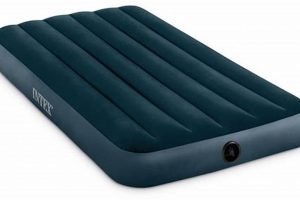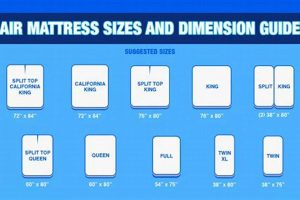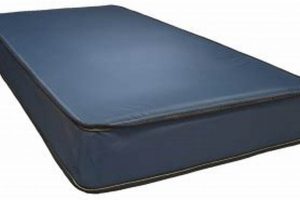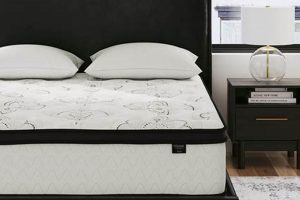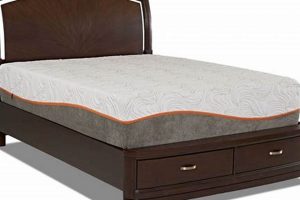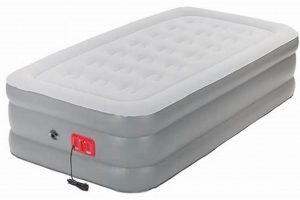A specific size of bedding designed for use on the upper or lower level of stacked sleeping arrangements is frequently required. This bedding is typically sized to fit a standard single bed frame, but is intended for a bunk bed configuration, where space efficiency is a primary concern. These mattresses often prioritize compactness and low profile to meet safety standards associated with bunk bed design, particularly upper bunks which have height limitations.
Utilizing the appropriately sized mattress is crucial for safety and comfort in bunk bed setups. A mattress that is too thick can reduce the height of the safety rails, diminishing their effectiveness in preventing falls. Selecting this size offers advantages in shared living spaces, children’s rooms, and accommodations where maximizing floor area is paramount. The design has evolved from basic straw-filled ticks to include innerspring, foam, and hybrid construction, reflecting advancements in sleep technology.
This discussion will now delve into the specifications, materials, and selection criteria relevant when choosing bedding of this type. It will also address common considerations such as mattress thickness, support, and durability, ensuring an informed purchase decision. Furthermore, the impact of different materials on sleep quality and potential health implications will be examined.
Essential Considerations for Selecting Bunk Bed Mattresses
Choosing the correct bedding for a bunk bed configuration requires careful consideration of several key factors to ensure safety, comfort, and longevity.
Tip 1: Height Restriction Adherence: Prioritize mattresses that comply with the bunk bed’s maximum height recommendation. Exceeding this limit compromises the safety rail’s effectiveness and increases the risk of falls, especially from the upper bunk.
Tip 2: Firmness Level Assessment: Select a firmness level appropriate for the intended user. Children and adolescents may benefit from a medium-firm mattress, while adults might prefer a firmer option for optimal spinal alignment.
Tip 3: Material Composition Scrutiny: Examine the materials used in construction. Foam mattresses offer affordability and pressure relief, while innerspring models provide enhanced support and airflow. Hybrid mattresses combine the benefits of both.
Tip 4: Durability Evaluation: Assess the overall durability of the mattress. Consider the density of the foam or the gauge of the coils, as these factors influence longevity and resistance to sagging.
Tip 5: Safety Certification Verification: Confirm that the bedding carries relevant safety certifications, such as CertiPUR-US, which indicates that the foam has been tested for harmful substances and emissions.
Tip 6: Weight Capacity Consideration: Adhere to the bunk bed’s and the mattress’s weight capacity specifications. Exceeding these limits can damage the structure and compromise the mattress’s performance.
Tip 7: Cover Material Choice: Select a cover material that is breathable and easy to clean. Look for hypoallergenic options to minimize the risk of allergic reactions.
By carefully considering height restrictions, firmness preferences, material composition, durability, safety certifications, and weight capacities, individuals can make informed decisions regarding bedding selections.
The subsequent sections will explore specific types and models of bedding suitable for bunk beds, offering further guidance in the purchasing process.
1. Dimensions and Size
The term “bunk mattress twin” inherently defines specific dimensional parameters. It designates bedding intended to fit within the confines of a standard twin-sized bunk bed frame. Deviation from these dimensions has direct consequences for safety and functionality. A mattress exceeding the specified length or width poses challenges in installation, potentially causing it to overhang the frame, which increases the risk of instability and physical hazards. Similarly, undersized bedding leaves gaps between the mattress and the frame, creating entrapment hazards and diminishing support.
The standardized dimensions of a twin mattresstypically 38 inches wide by 75 inches longserve as the foundational element of a “bunk mattress twin”. Consider, for example, a child’s bedroom where space is limited and a bunk bed is used. If the bedding is incorrectly sized, the child may experience discomfort, reduced sleep quality, and an increased chance of injury. Conversely, when the “bunk mattress twin” is properly sized, the bunk bed operates as intended, providing a safe and comfortable sleeping environment.
Therefore, understanding and adhering to these dimensional standards represents a critical component of selecting appropriate “bunk mattress twin” solutions. The failure to acknowledge the direct link between dimensions, safety, and user experience has ramifications, ranging from minor discomfort to potential injury. Prioritizing precise measurements ensures functionality and safety in bunk bed configurations.
2. Thickness Constraints
Thickness constraints constitute a defining characteristic of a “bunk mattress twin,” impacting both safety and usability. These limitations arise from the inherent design of bunk beds, where vertical space is restricted, particularly on the upper bunk. Excess mattress thickness reduces the height of the safety rails, diminishing their capacity to prevent falls. The relationship between mattress thickness and safety rail height is inversely proportional; as thickness increases, safety diminishes. For instance, many bunk bed manufacturers specify a maximum mattress thickness of 6 to 8 inches to maintain adequate rail height.
Failure to adhere to these limitations can have tangible consequences. Consider a situation where a 12-inch thick mattress is placed on the upper bunk. The resulting reduction in safety rail height might render it ineffective, particularly for active sleepers. Conversely, selecting a mattress that complies with specified thickness limits ensures that the safety rails perform as intended, reducing the potential for injury. Thickness also influences the overall comfort and structural integrity of the bunk bed. An overly thick mattress may exceed the weight capacity of the frame, leading to instability or damage.
In summary, thickness constraints are not merely a suggestion but a critical design consideration for “bunk mattress twin” selection. Compliance with these limits ensures user safety, maintains the structural integrity of the bunk bed, and optimizes available space. Ignoring these constraints poses significant risks and undermines the intended function of the bunk bed configuration. The practical significance of understanding and respecting thickness limitations cannot be overstated; it is an essential aspect of responsible product selection.
3. Support System
The support system within a “bunk mattress twin” is a critical determinant of its functionality, directly influencing comfort, spinal alignment, and overall durability. Different support systems, such as innerspring coils, foam cores, or hybrid configurations, exhibit varying degrees of responsiveness and load-bearing capacity. The choice of support system must consider the intended users weight, sleeping position, and any specific orthopedic needs. For example, a lightweight child might find sufficient support in a foam core mattress, while an adult or heavier individual may require the more robust support offered by an innerspring or hybrid system.
The selection of an inappropriate support system can lead to compromised comfort and potential health issues. A mattress lacking adequate support can cause spinal misalignment, resulting in back pain or discomfort. Conversely, an overly firm support system might exert excessive pressure on certain areas of the body, leading to pressure points and restless sleep. The interaction between the support system and other mattress components, such as comfort layers, further impacts the overall sleeping experience. A well-designed support system distributes weight evenly, minimizing pressure points and promoting proper spinal alignment, even within the confined dimensions of a “bunk mattress twin”.
In conclusion, the support system forms the foundation of a “bunk mattress twin’s” performance. Careful consideration of the intended users characteristics and the inherent properties of different support systems is paramount for selecting a mattress that promotes restful sleep and minimizes the risk of discomfort or injury. The appropriate choice of support system significantly enhances the overall value and utility of the bunk bed configuration. The long-term implications of this selection affect user health and the longevity of the product itself.
4. Material Composition
The material composition of a “bunk mattress twin” directly influences its performance characteristics, encompassing factors such as comfort, durability, safety, and hygiene. The choice of materials, including the core, comfort layers, and cover, determines the mattress’s ability to provide adequate support, regulate temperature, and resist allergens. Innerspring coils, memory foam, latex, and polyester blends each offer distinct properties that contribute to the overall sleeping experience. For example, a mattress incorporating natural latex may provide enhanced breathability and hypoallergenic properties, while one constructed with low-density foam could offer limited support and reduced longevity. The specific materials utilized are not merely aesthetic choices but fundamental determinants of the mattress’s suitability for its intended purpose.
The composition of a “bunk mattress twin” also has significant implications for fire safety and compliance with regulatory standards. Mattresses are often required to meet specific flammability requirements, which may necessitate the inclusion of fire-retardant materials. The selection of these materials must balance safety considerations with potential impacts on comfort and environmental concerns. Furthermore, the breathability of the materials affects the mattress’s ability to dissipate heat and moisture, which can influence sleep quality and hygiene. For instance, a non-breathable cover can trap heat and moisture, creating an environment conducive to microbial growth. This connection underscores the importance of carefully evaluating the material composition to ensure that the “bunk mattress twin” is not only comfortable and supportive but also safe and hygienic.
In conclusion, the material composition represents a foundational element in the design and selection of a “bunk mattress twin.” The interplay between different materials dictates the mattress’s comfort, durability, safety, and hygienic properties. A comprehensive understanding of material characteristics is crucial for making informed purchasing decisions, ensuring that the selected “bunk mattress twin” meets the specific needs and priorities of the intended users while adhering to relevant safety standards. Disregarding material composition compromises the long-term utility and value of the product.
5. Safety Standards
The application of safety standards to “bunk mattress twin” designs is of paramount importance, governing manufacturing practices and material selection to protect users from potential hazards. These standards are multifaceted, addressing concerns ranging from flammability to structural integrity. Compliance with these benchmarks is not merely a regulatory formality, but a fundamental aspect of ensuring user well-being.
- Flammability Resistance
A key aspect of safety standards for “bunk mattress twin” products involves resistance to fire. Regulations such as 16 CFR Part 1633 mandate specific testing protocols to minimize the risk of ignition and slow the spread of flames. For instance, mattresses must withstand exposure to open flames and smoldering materials for a specified duration without excessive burning. Failure to meet these standards elevates the risk of injury or death in the event of a fire.
- Low VOC Emissions
The emission of volatile organic compounds (VOCs) from mattress materials represents another critical area addressed by safety standards. Certifications such as CertiPUR-US ensure that foam components used in “bunk mattress twin” products are tested for harmful chemicals and meet stringent emission limits. High VOC levels can lead to respiratory irritation, allergic reactions, and other adverse health effects. Compliance with low VOC emission standards mitigates these risks.
- Height Restrictions
Safety standards directly address height limitations for “bunk mattress twin” bedding to maintain the effectiveness of bunk bed safety rails. Exceeding the recommended mattress height diminishes the protective function of the rails, increasing the potential for falls, particularly from the upper bunk. Adherence to these restrictions ensures adequate rail height above the mattress surface, minimizing the risk of accidental falls during sleep.
- Weight Capacity Adherence
Weight capacity is a critical safety consideration for both the bunk bed frame and the associated mattress. Safety standards dictate that “bunk mattress twin” products must be designed to withstand a specified weight load without compromising structural integrity. Exceeding the weight limit can lead to mattress sagging, frame damage, or even complete failure, posing a significant safety hazard. Clear communication of weight restrictions is essential for preventing misuse.
These multifaceted safety standards underscore the importance of meticulous attention to detail in the design and manufacture of “bunk mattress twin” products. From flammability resistance to VOC emissions, height restrictions, and weight capacity adherence, each facet contributes to a safer sleeping environment. Neglecting any of these aspects compromises user safety and undermines the intended function of the bunk bed system. Responsible manufacturers prioritize compliance with these standards to safeguard the well-being of c
onsumers.
Frequently Asked Questions
The following questions address common concerns and misconceptions regarding the selection and usage of “bunk mattress twin” bedding, providing clarity on critical aspects of safety, comfort, and performance.
Question 1: What is the standard size of a “bunk mattress twin?”
A “bunk mattress twin” typically conforms to standard twin mattress dimensions, measuring approximately 38 inches in width and 75 inches in length. However, verifying the specific dimensions with the bunk bed frame manufacturer is advisable to ensure compatibility.
Question 2: How does the thickness of a “bunk mattress twin” affect safety?
Thickness is a crucial safety consideration. A “bunk mattress twin” that is too thick reduces the height of the safety rails on the upper bunk, increasing the risk of falls. Manufacturers generally recommend a maximum thickness, often between 6 and 8 inches, to maintain adequate rail height.
Question 3: What type of support system is best for a “bunk mattress twin?”
The ideal support system depends on the user’s weight, sleeping position, and comfort preferences. Innerspring coils provide robust support, while foam cores offer pressure relief. Hybrid mattresses combine both for a balanced approach. Consider the intended user’s needs when selecting the support system.
Question 4: What materials are commonly used in “bunk mattress twin” construction, and what are their benefits?
Common materials include innerspring coils, memory foam, latex, and polyester blends. Innerspring coils offer support and airflow, memory foam conforms to the body, latex provides breathability and hypoallergenic properties, and polyester blends are often used in covers for durability and ease of cleaning. Each material contributes unique benefits.
Question 5: What safety certifications should one look for when purchasing a “bunk mattress twin?”
Look for certifications such as CertiPUR-US, which indicates that the foam has been tested for harmful substances and low VOC emissions. Compliance with flammability standards, as outlined in 16 CFR Part 1633, is also essential. These certifications provide assurance of product safety and quality.
Question 6: How does one properly maintain a “bunk mattress twin” to ensure its longevity?
Regularly rotating the mattress can help distribute wear and prevent sagging. Using a mattress protector safeguards against spills and stains. Vacuuming the mattress periodically removes dust and allergens. Adhering to the manufacturer’s cleaning instructions is crucial for maintaining hygiene and extending the mattress’s lifespan.
Selecting the right “bunk mattress twin” requires careful consideration of size, thickness, support system, materials, and safety certifications. Proper maintenance contributes to its longevity and ensures a safe, comfortable sleeping environment.
The subsequent sections will delve into specific product recommendations and reviews, providing further guidance in the purchasing process.
Conclusion
The preceding discussion has comprehensively examined the critical attributes of bedding designed for bunk bed configurations. Precise sizing, adherence to thickness constraints, appropriate selection of support systems and materials, and rigorous compliance with safety standards are paramount. The ramifications of neglecting these factors extend beyond mere discomfort, potentially impacting user safety and the structural integrity of the bed frame itself.
Therefore, informed decision-making regarding the selection represents a prudent investment in both safety and well-being. Recognizing the inherent limitations and unique demands of bunk bed environments ensures responsible product choices that contribute to a secure and restful sleeping experience. Further research and diligent evaluation of available options are strongly encouraged to optimize the selection process.


